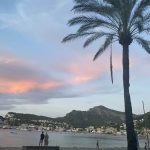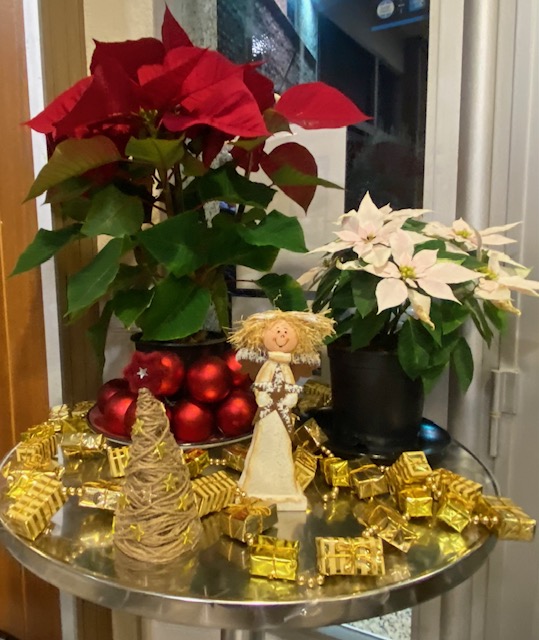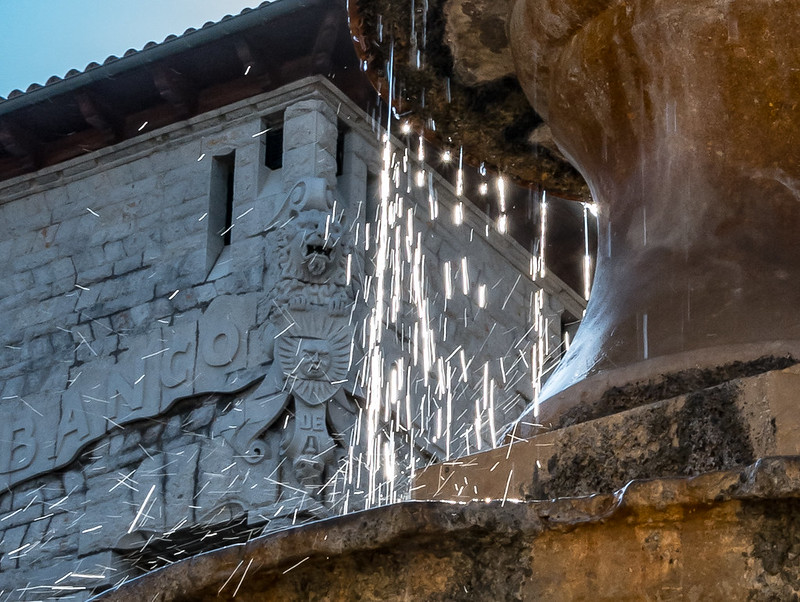WEST TO NORTHWEST MALLORCA
A little information for our visitors
By Shirley Roberts

The west coast of Mallorca has a uniqueness not given too many places. It is a UNESCO heritage site in honour of the Moorish influence of the past on the water collection of the area. The Tramuntana Mountains in all their glory are the backdrop to this outstanding location. They run the whole west coast from Estellencs to Formentor keeping the secrets of the past and the promises for the future in this never to be forgotten landscape. Water is the key to sustainable life and tourism on this island and the collection of water was the first priority of the Moors when they inhabited this land centuries ago. They carved out the mountains to make olive terraces and created dry stone water channels throughout the mountains to collect every drop of rain that fell. This is the gift of generations past to us today and why we live in a green and pleasant land where water is plentiful and the sun shines.
The West coast of Mallorca incorporates Estellencs, Banyalbufar, Valldemossa, Deia, Soller, Fornalutx, Escorca, Pollensa and Formentor. This represents almost half the island of Mallorca and many of our mountain towns and villages. The City of Soller has been designated by UNESCO as the Cultural Centre and it is the large heart of the whole area. All other towns on the list have wonderful qualities and their own special claims to fame but it is to Soller that many people go to start their adventures on the North West coast of Mallorca.
ESTELLENCS
Our journey starts in Estellencs under the watchful eye of the Galatzo mountain. This area of outstanding natural beauty has many fans. They see this is the heart of rural Mallorca without any of the commercial trappings that are found a few miles away. The mountain behind and the rocky cove below from which to have that all important cool down is what Estellencs does best. The woodland around the area are recovering from the forest fire that devastated parts of this region a few years ago. The rebirth and growth of the new forest is a delight to behold and a once in a generation opportunity to see the phoenix rise from the ashes.
BANYALBUFAR
Banyalbufar has four small mountains to itself and sits in the heart of craggy natural beauty. It is open to the sea from the Port of Canonge and the pine walks of the area make this a favoured place for locals and visitors. The coves and inlets of the area and the stunning walks make this a place that everyone want to keep to themselves like a ‘best kept secret’.
VALLDEMOSSA
Valldemossa rises from the road with its turrets gleaming and a sense of excitement as you arrive in a busy, bustling place. This place is on the map because of its stunning location and beauty in the heart of the Tramuntana and thanks to Chopin. The Monastery of Valldemossa housed the composer Chopin and his wife for a brief time and that created a bond which will never be broken. Chopin is played in the museum each day and pilgrimages are made by those who love his music. Valldemossa is famous for being the birthplace of Santa Catalina Thomas who is a Saint of Mallorca. Her image is to be found on the entrance to many local houses as a sign of welcome to the visitor. This is also the place you must eat the local Coco de Patatas – this is a sweet bun made with potato flour and sprinkled with icing sugar. This is a delicacy to have with coffee round these parts. Valldemossa claims to be the best bakers of these on the Island.
DEIA
The road from Valldemossa to Deia hugs the coastline and makes it one of the journeys of the world for its glorious sunsets and fantastic mountain and sea views. Deia is the village that has many books already written about it. The people, their rock and roll lives and the history make this a very special place. The incomers outnumber the residents and the common language is English. Deia was the spiritual home to so many artists, writers and creative people from the 1930’s onwards and continues to be today. Many famous people have homes here and the summer is full of them and their friends just enjoying this natural place. The mountains enfold you as the sun goes down and the night life of Deia comes into its own. Café Society, impromptu music and dancing and a general appreciation of all the good things that life has to offer is contained in this place. A trip to the cemetery of Deia reads like a ‘who’s who’ – so many people came, made their lives here and left their mark before staying forever.
SOLLER
Soller has a train that links it on one of the most picturesque train journeys of the world to Palma. The journey through the Tramunatana is an expert feat of engineering and tunnels. The descent into Soller has everybody marveling about how it happened. The train stops at a look out point as it enters the Soller Valley and passengers are allowed to get off to take pictures. From that point it is hard to see how the train will ever get down the mountain – it does – every time. The Soller Tram is waiting for the train and will take you in its old fashioned way through the back gardens of Soller and down to the sea. A throwback to the past and to the trams links with San Francisco and Portugal before they arrived here. The City and the Port are linked in a way that no other place on the island is. There are many places in Mallorca which have inland towns and ports but it is only in Soller that the transport links allow them to be one place.
THE PORT OF SOLLER
The Port of Soller is the playground of the City and is a civilised beach resort. The yachts set sail every day taking their private day charters off for the highlight of their holiday. The sea is the vast playground of the Port of Soller with many caves and coves waiting to be discovered. Some restaurants such as Foradada – near Deia are only accessible by sea and become a magical lunch stop on the yacht trips. In the other direction the sea takes you the easy way to Sa Colobra and the gorge which is the starting point for so many tortuous walks through the mountains. The Repic Beach of the Port of Soller hosts the fine dining of the area with all the great restaurants spilling out to the beach terrace. The Santa Catalina side of the resort has the pleasure of watching as the day’s catch of Soller prawns are brought in by the fishing fleet and sold at the waters edge before most being taken off in refrigerated lorries to the excellent restaurants of Palma and beyond.
FORNALUTX
Fornalutx is a village above Soller which has earned the title ‘Prettiest Village in Spain’ on a number of occasions. It is nestled in the dip in front of the highest mountains of Mallorca and is aptly named Fornalutx which translates to ‘oven of the sun’. It is always hotter there than in Soller in the summer and colder in the winter. The unrivalled beauty of Fornalutx and its situation in the Tramuntanta has earned it a place on many posters advertising Spain worldwide. To stroll its cobbled streets or relax with a cool drink in the square is a must for a holiday in these parts.
BINIARAIX
The hamlet of Biniaraix just down the road from Fornalutx is best known for its location as the starting point for the walks to the Puig de Massanella along the Barranc de Biniaraix. Walkers have long known about this wonderful place and it is a ‘must do’ walk on the Tramuntana list. A circuitous driving route through the outskirts of Soller brings you to the road entrance to Biniaraix which is so narrow that often people drive on. They can’t believe that the gap is really the road entrance to this lovely place.
ESCORCA
Escorca is the place in the heart of the Tramuntana between Fornalutx and Pollensa which is mainly mountains. It is sparsely inhabited apart from a few roadside stops for food and refreshment. There are many more sheep in Escorca than people that is until you come to Lluch. The drive over the mountains towards Pollensa is a stunning journey and one where you are at one with nature for the whole route.
LLUC
The Monastery of Lluc is centred here and it is a place of pilgrimage and huge historical interest. The Black Madonna is found in the Chapel in Lluch and the Bluets sing at mass every day. The choir school is world famous and on special days in the church calendar this isolated place in the mountains is visited by thousands to listen to the music and take part in the mass. Lluch offers hospitality and accommodation here in what used to be the priests rooms and part of it has become a rural hotel.
POLLENSA
The road from the mountains leads on to Pollensa and the Port of Pollensa much loved by holiday makers. This is favoured area of English speaking families who return year after year for their children to have their bucket and spade holidays in the wonderful welcoming resorts of this part of the island. The increase in cycling as a sporting and holiday activity has also centred on the flat terrain of the area between Pollensa and Alcudia. The racing teams from many countries set up their training camps here in the winter and beautiful autumn and winter days are spent enjoying their sport.
FORMENTOR
Formentor is on the northern most point of Mallorca and the end of the west of the Island. The road which links the Port of Pollensa to Formentor was built by the clever engineer – Antonio Parietti who also designed the road to Sa Colobra – much beloved of cyclists. Formentor is the beautiful place where the winds meet and its own micro climate comes into play. The rich and famous make their way to the beauty and isolation of this glorious place or just simply turn up on their yachts. The end of the island it may be but it is the beginning of many a wonderful holiday and a special place for lovers.
THE TRAMUNTANA
The Tramuntana is the cement that holds this whole area together. The towns, villages and the City of Soller share much but they are all proud independent places that consider what they have to offer to the visitor is unique. Many of the places on our list have their own town Halls and their own Mayor and this is very important in the way they view themselves. UNESCO recognised this as a major feature when the area was created a Heritage Site. The respect for the labours of the past that has created the Mallorca you see today is clear in the desire that the people have to continue the improvements that can be left for the next generation.







